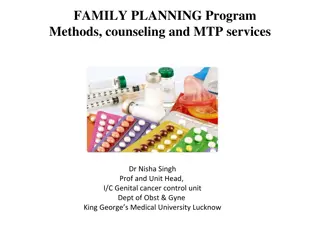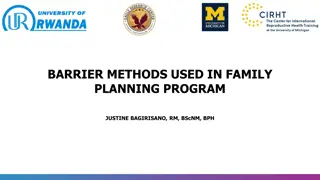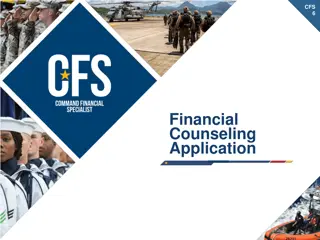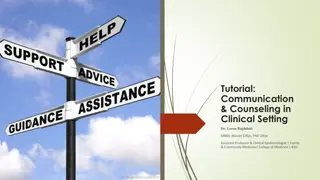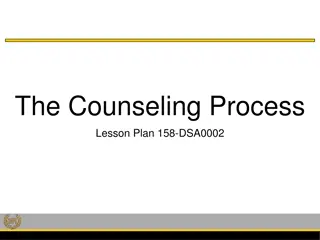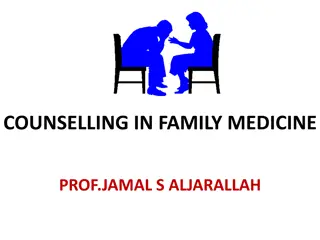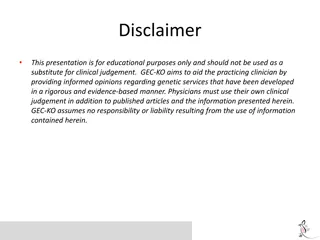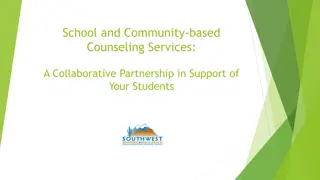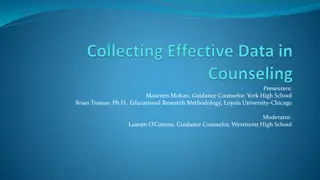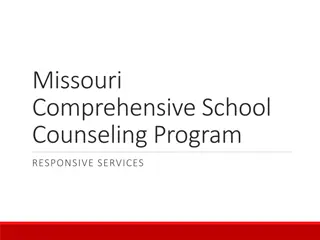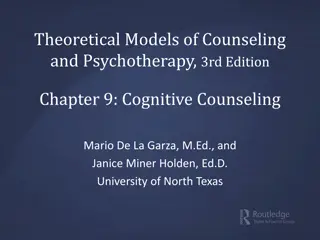Family Planning Counseling: Importance and Impact
Family planning counseling is crucial for ensuring informed decision-making, quality service provision, and the adoption of family planning methods. Effective counseling helps clients choose suitable methods, use them correctly, and continue with satisfaction. Poor counseling can lead to adverse outcomes like incorrect method use, dissatisfaction, and health risks.
Download Presentation

Please find below an Image/Link to download the presentation.
The content on the website is provided AS IS for your information and personal use only. It may not be sold, licensed, or shared on other websites without obtaining consent from the author. Download presentation by click this link. If you encounter any issues during the download, it is possible that the publisher has removed the file from their server.
E N D
Presentation Transcript
CHAPTER SIX FAMILY PLANNING COUNSELING
At the end of the session students will be able to: Define client-provider interaction Define good counseling & its role in informed & voluntary decision making Identify specific tasks that need to be carried out in counseling Explain advantage of good counseling and outcomes of poor counseling
Discussion Questions What is counseling? Why do we do counseling? How does counseling help clients? How does counseling help us (as service providers and as a FP program)? What factors affect counseling
Counseling Definition: Counseling is a type of client-provider interaction that involves two-way communication b/n a health care staff Member/ provider& a client for the purpose of confirming or facilitating a decision by the client or helping the client address problems or concerns.
Importance of Counseling It ensures clients right to informed and voluntary decision making It is an essential element of quality FP services It is a key determinant of the adoption and continuation of family planning
What does effective counseling do to clients? Effective counseling:- Enables clients to choose a method that suits their needs Enables clients to use their chosen method correctly Enables the client to continue using a FP method with satisfaction Informs and prepares clients for side effects
Effects of poor counseling Exercise Effect Possible Outcomes Incorrect method use Not counseled for side effect Failure to recognize serious warning signs Does not suit - dissatisfaction with method
Consequences of poor counseling Effect Outcome Unwanted pregnancy Incorrect method use Not counseled for side effect Dissatisfaction / Discontinuation Failure to recognize serious warning signs Health risk Does not suit - dissatisfaction with method . Drop out . Poor word of-mouth . Low utilization
Tasks during counseling When providing counseling Helping clients to assess their own needs for services, information, and emotional support Providing information appropriate to clients identified problems and needs Assisting clients in making their own voluntary and informed decisions by helping them weigh the options
Tasks contd Helping clients explore possible barriers to the implementation of their decisions and helping them develop the strategies and skills to overcome those barriers, and carry out their decisions Answering questions and addressing concerns, and making sure the clients understand all the information they have received
Session Objective Define informed & voluntary decision making& client- provider interaction Explain the importance of informed & voluntary decision making in FP and RH List the elements that support informed voluntary decision making Explain the clients rights and staff needs
Informed & voluntary decisions Definition: The process by which an individual arrives at a decision about health care, based on options, information, and understanding
Benefits of informed & voluntary decision making in FP services Better use of methods - greater effectiveness Higher continuation rate More satisfied clients There will be good program promoters
PRINCIPLES OF GOOD CLIENT-PROVIDER INTERACTION Treat each client with respect Tailor the interaction to the individual client s needs, circumstances, and concerns Interact; elicit the client s active participation
Contd Avoid information overload Provide the client s preferred method (for FP) or address the client s primary concern (for other SRH issues) Use and provide memory aids
Session objectives: By the end of the session, students will be able to: Explain how providers beliefs and attitudes can affect their interactions with clients, both positively and negatively Explain the importance of being aware of our own beliefs and attitudes so we can avoid imposing them on clients or having them become barriers to communication
(Beliefs & Attitudes) Brain storm What are beliefs means ? What is Attitude ? How our beliefs influence our attitudes ?
Definitions : Beliefs are concepts and ideas that are accepted and thought to be true Attitude is the way we think about and act toward particular people or ideas
Large group exercises Group I AGREE Group II DISAGREE Group III - UNSURE Present cases
Important points about beliefs & attitude Our beliefs shape our attitudes Our beliefs are often so ingrained that we are unaware of them until we confront a situation that challenges them How we communicate our beliefs and attitudes (both verbally and nonverbally) Everyone has a right to his or her own beliefs. However, as health care providers, we have a professional obligation to provide health care, and to do so in a respectful and nonjudgmental manner
Session objectives : By end of the session, students will able to: Discuss the use of some affirmative words during communication Explain different communication techniques and their advantage Discuss how the communication techniques can affect the client-provider interaction during counseling Describe the appropriate provider s attitude when faced with challenging moments in counseling
Two key aspects where good communication contributes to counseling most Communication skills are used in all phases of counseling to build trust and a positive environment between the client and the provider The following skills help explore the reason for client s visit, and the context (factors) in which the client makes decisions. asking questions, active listening paraphrasing
Key Words and concepts Respect, Praise Encouragement Paraphrasing
Respect exercise Ask participants how they show respect to their clients in their own facility setting Ask why showing respect is important
Brainstorming questions / discussions What does praise means? What does encouragement means? How do you praise and encourage your clients? How could praise and encouragement be useful in building rapport with clients?
Praise and Encouragement Definitions: Praise Is the expression of recognition, approval, and admiration Encouragement Is the provision of support, courage, confidence, & hope
THREE ASPECTS OF COMMUNICATION The following three key components of communication have been shown to have varying degrees of impact on the person(s) with whom you are interacting: Body Language = 55% Tone of Voice = 38% Actual Words = 7%
Brain storming & discussion points Communication Techniques Non-verbal communication Positive non-verbal Negative non-verbal Asking questions Open ended questions Closed ended questions Listening and paraphrasing
Purpose of asking questions during counseling? To elicit information about the client s circumstances, health status, and FP needs and knowledge To establish a good relationship by showing concern and interest To determine what educational /language level will be most easily understood by the client
Purpose of asking questions To explore the reason(s) for client s visit, the client's circumstances, past history/experience, current situation and future plans To prioritize key issues to target during the counseling session To learn what the client already knows and avoid repeating such information To identify areas of misinformation that need to be corrected
PARAPHRASING Paraphrasing means restating the client s message simply and in your own words.
The purposes of paraphrasing are to: Make sure you correctly understand the client Lets the client know that you are trying to understand what he or she is saying Clarify what client is saying
CHALLENGING MOMENTS IN COUNSELING Client becomes silent Client cries Client refuses help Client feels not important Client is uncomfortable with the provider
CHALLENGING MOMENTS Client accuses the provider Provider believes that there is no solution to the problem the client has come for Provider makes mistake(s) Provider doesn t know the answer to the client s question Provider is short of time
Our clients can be grouped depending on:- CLIENTS BY REASON FOR VISIT CLIENTS BY FERTILITY PLAN CLIENTS BY POPULATION GROUP CLIENTS BY TIMING OF LAST PREGNANCY
CLIENTS BY REASON FOR VISIT: New clients who have no method in mind New clients with a method in mind Clients returning for re-supply (satisfied return clients) Clients returning with problems or a different need (such as dissatisfied return clients)
Part II Session I Introduction to the REDI Framework Session Objectives By the end of the session, students will be able to: Describe REDI, a framework for FP counseling
Basic steps in counseling ( REDI Approach) R-Rapport building. E -Exploration D -Decision making I -Implementing the decision 39
R-Rapport Building (step one) Greet the client Make introductions Ensure confidentiality Help the client to relax and feel comfortable Inform the need to talk about sensitive matters 40
E-Exploration (step two). Explore the client s needs, risks, sexual life, social context Reproductive goal Assess the FP experience or knowledge and provide information Explain the available methods R/O pregnancy and MEC Address misconception 41
D- Decision Making (step three) Identify what decisions the client needs to make Help the client weigh benefits, disadvantages and consequences Mention the options for each decision Confirm the decision is made by the client 42
I-Implementing the decision (step four) Make specific plan for carrying out the decision Provide the skills that the client need to use the method Identify the barriers for implementing the decision and help clients overcome them Make a plan for follow up 43
What are the key principles when you give information to the client? Find out what the client already knows Identify information gaps that need to be filled or misconceptions that need to be corrected Find out the client s need or problem
How can we help clients understand & remember the information we give them ? Tailor information to the client s needs Make information understandable Personalize information for the client Put information in terms of the client s situation Help the client understand what the new information means to her or him personally
Exploring & handling clients misconceptions Find out what the client needs to know to have confidence in the FP method Give the correct information. Be aware of traditional beliefs Encourage clients to check with a service provider about what they heard
Exploring & handling clients misconceptions Ask clients what they have heard about FP methods and what concerns they have about the methods Take the client s concern or misconception seriously Try to find out where the client heard the misconception or rumor Explain tactfully why the misconception or rumor is not true
Reasons for Clients Return Visits Resupply of method Follow up of a method or procedure Concern Side effect Want to be pregnant
Exercise Barriers :- Talking with Partners about FP & SRH Clients reasons Deeper Personal & social factors I cannot tell him that I want to use family planning because he thinks that it goes against Our religion. My partner will think I am cheating if I ask him to use condoms. I cannot tell her that I have an STI because then she will know that I cheat on her. Following social norms and values Fear of losing the relationship; fear of Violence Fear of a negative reaction
Why does the client want to discontinue the method?



